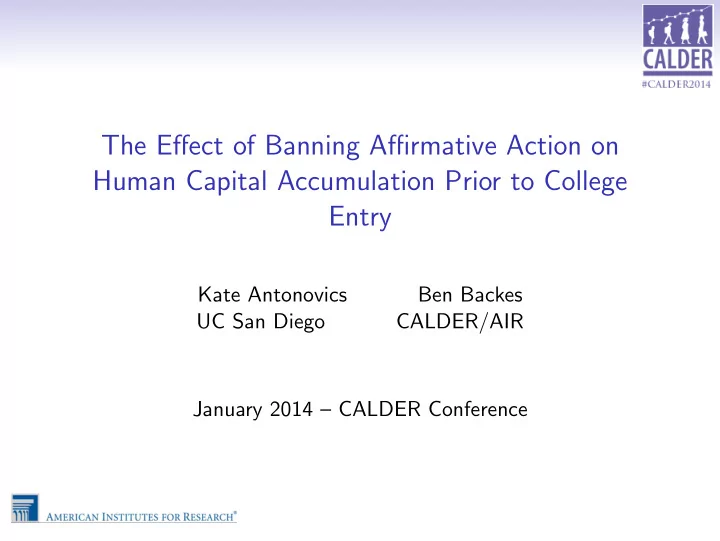

The Effect of Banning Affirmative Action on Human Capital Accumulation Prior to College Entry Kate Antonovics Ben Backes UC San Diego CALDER/AIR January 2014 – CALDER Conference
Motivation • Popular debate surrounding affirmative action focuses on how it affects the allocation of students to universities, taking the achievement of high school graduates as fixed • However, disparities in educational preparation arise early in the education process and are formed well before college admissions come into play
Motivation • Popular debate surrounding affirmative action focuses on how it affects the allocation of students to universities, taking the achievement of high school graduates as fixed • However, disparities in educational preparation arise early in the education process and are formed well before college admissions come into play • As affirmative action was originally conceived to mitigate these gaps in racial achievement, it is natural to ask whether and how the removal of racial preferences affects these gaps
In this paper... • We examine SAT scores and high school GPA for students in California • Examine how these measures changed in California after Prop 209
The Treatment 1. Large falls in acceptance rates for URMs • URMs: 52% of applicants admitted to Berkeley in 1995-97, 25% 1998-2000 • Non-URMs: 32% admitted in 1995-97, 28% 1998-2000
The Treatment 1. Large falls in acceptance rates for URMs • URMs: 52% of applicants admitted to Berkeley in 1995-97, 25% 1998-2000 • Non-URMs: 32% admitted in 1995-97, 28% 1998-2000 2. Evidence of change in admissions process to favor URMs: • SAT math less important predictor of admission • High school GPA more important predictor of admission at most selective UCs • Disadvantaged family background more predictive of admission
Why Might Behavior Change? 1. Change in admissions process • Direct effect through URM admissions rate • Indirect effect through weights placed on different factors 2. Institutional discouragement from attending college for groups affected by affirmative action ban
Why Might Behavior Change? 1. Change in admissions process • Direct effect through URM admissions rate • Indirect effect through weights placed on different factors 2. Institutional discouragement from attending college for groups affected by affirmative action ban • Theory does not yield definitive predictions about whether the racial gap in human capital investment will increase or decrease and whether the overall level of human capital investment (regardless of race) will go up or down
College Application Process 1. Study in high school (SAT/GPA) 2. Apply to colleges 3. Enroll at a college that accepted you
College Application Process 1. Study in high school (SAT/GPA) (? – this paper) 2. Apply to colleges (relatively stable) 3. Enroll at a university given available choices (relatively stable)
Previous Empirical Studies • Cullen et al (2012) and Cortes and Friedson (2011) find evidence that students moved school districts to maximize their chances of qualifying for the Texas top 10% plan
Previous Empirical Studies • Cullen et al (2012) and Cortes and Friedson (2011) find evidence that students moved school districts to maximize their chances of qualifying for the Texas top 10% plan • Furstenberg (2010) and Caldwell (2010) find statistically significant increases in black-white SAT (Furstenberg) and PIAT (Caldwell) gap in California • Furstenberg: limited data from before Prop 209, smaller sample • Caldwell: NLSY not representative and small samples
Empirical Strategy Basic difference-in-difference-in-difference (DDD): 1. Compare racial achievement gap in California to gap in other states 2. Measure performance of Californians as a whole
Regression Results SAT M SAT V GPA CA*Post 0.00 0.02*** 0.02*** (0.01) (0.00) (0.01)
Regression Results SAT M SAT V GPA CA*Post 0.00 0.02*** 0.02*** (0.01) (0.00) (0.01) CA*Post*Black 0.02 0.01 0.07*** (0.01) (0.01) (0.01) CA*Post*Hispanic -0.03*** -0.03*** 0.06*** (0.01) (0.01) (0.02) Observations 2648191 2648191 2648191 R-squared 0.25 0.24 0.13
Variability of SAT Math Scores SAT Math Scores in Various States .6 Normalized Math Score .4 .2 0 −.2 1994 1996 1998 2000 2002 year CA AL AK AZ AR CO CT DE
Statistical Inference with One Treated Unit • Solution: construct the empirical distribution of variability in test scores by treating each control state as the treated state • Null hypothesis rejected when estimate for California is large relative to the control states
Distribution of “Placebo” Estimates SAT Math SAT Verbal GPA 15 15 15 10 10 10 Frequency 5 5 5 0 0 0 −.4 −.2 0 .2 −.4 −.2 0 .2 .4 −.3 −.2 −.1 0 .1 .2
Extensions • Similar pattern holds for subsamples • Parental education • Achievement • Students likely to send SAT scores to Berkeley or UCLA • Other datasets also imprecise
Limitations • Sample ends relatively short time after Prop 209 • Many observations aren’t plausibly affected by the policy change • Measures come relatively late in student’s life
Discussion • Estimates extremely small in magnitude • Even a large effect would be difficult to detect • Important in light of UC’s changes in admissions process
Discussion • Estimates extremely small in magnitude • Even a large effect would be difficult to detect • Important in light of UC’s changes in admissions process • As more states ban affirmative action, perhaps we will have better evidence
Recommend
More recommend